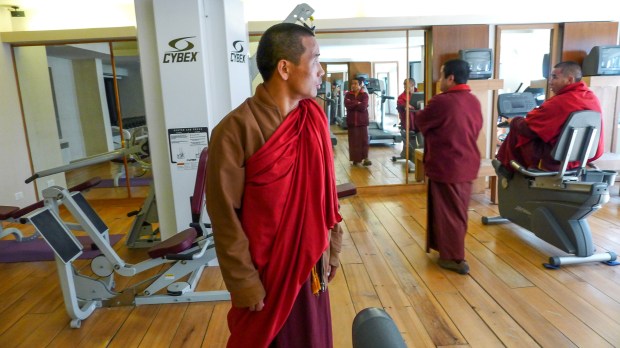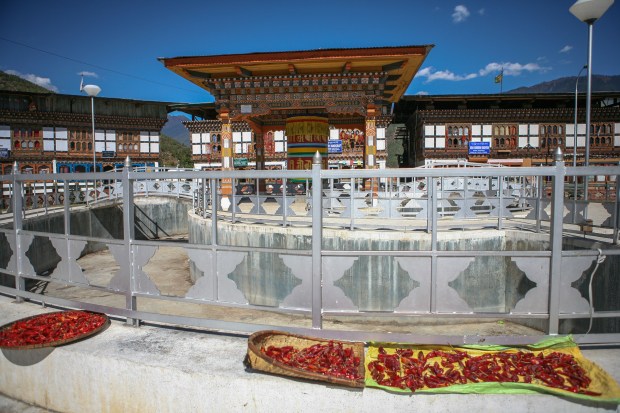- Don’t expect to travel freely. Bhutan is not a budget destination or a place for backpacker-style drifting. It started opening up to outsiders only in the 1970s, and it still closely guards its heritage and ecology by restricting tourism. Travel must be arranged through government-approved agencies and be paid in full before you score a visa (citizens of Bangladesh, India, and Maldives are exempt), which costs an eye-watering $250-per-day ($200- during the low season). Your visa covers a guide and a bespoke itinerary, including transport, accommodation, sightseeing, and meals; $65 of the fee serves as a government tax, which goes to public services like education and healthcare. Note: If you’re traveling alone, you’ll have to shell out an additional $40 a day.
- Mind your guide. Well-drilled tour guides, wearing the traditional gho or its female equivalent, kira, will be at your side throughout, offering useful information about religion, culture, and anything you want to know about Bhutan—as long as it’s not controversial. Most guides steer visitors away from any discussion of “Western influence” that might complicate the tourism board’s official narrative of Bhutan’s Shangri-La status. Although most Bhutanese will discuss with their fellow countrymen the unrealistic expectations that Gross National Happiness—the national development index based on spiritual values—places on people, they probably won’t bad-mouth it in front of foreigners. On your last day it’s customary to tip your guide—about $15 to $20 for each tour day—or offer a small gift from your country.
- Bring dollars. Or rupees. Your visa fee covers most things, but if you want spending money, you’ll need cash. There are some ATMs in the larger towns, but they’re about 70 percent reliable and you can only withdraw small amounts. You can spend U.S. dollars or change them into the local currency, ngultrum (“nu” for short). Or skip the lines by changing money with your guide. Indian rupees are accepted almost everywhere too: India is Bhutan’s closest trade and foreign policy partner, and the nu is pegged to the rupee.

- BYO smokes. Bhutan is the only country in the world that completely bans the sale and production of tobacco—and naturally, smoking is banned in public places. Tourists and the Bhutanese elite can bring in 200 cigarettes, but ask your guide to find a place to light up. Hotels will accommodate smokers, some local bars and restaurants have indoor smoking rooms, and many nightclubs informally allow it after dark. Importing cigarettes overland from India (for personal use) is allowed, but they’re slapped with a duty of up to 200 percent. Smuggling tobacco can net someone three years in prison, but the black market is flourishing. Because it’s not feasible for most Bhutanese to go on expensive cigarette runs, local smokers buy them from “dealers” at market stalls. Don’t count on doing the same: Dealers will only sell to people they already know. Bring your own.

- Try the legal stimulant. Dolma, an addictive mixture of areca nut, lime paste, and betel leaf, is deeply woven into the cultural landscape. You’ll find friends sharing a bag after meeting; you’ll find it as an offering at religious ceremonies and alongside plates of candies at events; you’ll find it passed around before and after meals. If you don’t notice it by sight—red stains cover most streets, and its users’ teeth are covered in a red sticky residue—its pungent aroma will wake you up. (Don’t be fooled by its natural appearance. Sold in small plastic bags or cone-shaped papers, this seemingly benign combination of leaf, lime, and nut contains many unnatural chemicals that are extremely bad for your health.) Trying it won’t kill you, but it will most likely give you the spins. For me, altitude is enough.
- Feel the burn. The Bhutanese believe a meal is unworthy without chili peppers. If you agree, you’ll be in heaven. The country’s national dish, ema datsi, is a simple fiery curry of chilies and farmer’s cheese, always paired with a generous helping of nutty red rice. Often topped off with ezay, a salsa made from (what else?) dried chilies, this dish can feel like an assault on your senses. But if you can’t get enough, go to the subjee (vegetable) market and ask for dole, a small, red, circular chili, ranked one of the hottest in the world. To eat dole like a local, dip the chili into salt, take a bite, and then shove a handful of rice into your mouth. In Thimphu, Ama’s Downstairs Lounge & Bar (also a karaoke joint) is a good place to ease into ema datsi and its other incarnations. In Paro, try Dagmar.
- Don’t disrespect the royals. Bhutan reformed from an absolute monarchy to a constitutional monarchy in 2008, but the royals are still perceived as incarnations of gods. Criticizing them is akin to blasphemy. Other no-gos include the Nepali “issue”—an estimated 100,000 southern Bhutanese (ethnic Nepalis) were deported in the early 1990s—and religious figures. If you want to try for a meatier dialogue with your guide, start by reading Karma Phuntsho’s The History of Bhutan before you get there. Your guide will be impressed you’ve done your research, and it might lead to a more honest conversation about current Bhutanese development and politics.

- Eat farm and table. To break up the monotonous array of dishes in Bhutan’s hotels and restaurants, ask your guide to arrange a meal at a farmhouse, which is usually manned by a hospitable farmer. The menu is sourced from what’s in season and available. In spring you might find fiddlehead ferns and leafy spinach sprinkled into curries, in summer asparagus, in autumn succulent matsutake mushrooms, and in winter the warming potato-and-turnip curries topped over red rice will send you into a carb coma. Be ready to sit on the floor, eat with your hands, and consume your weight in red rice as the traditional stove (bukhari) keeps both you and a kettle of sweet milk tea (naja) or butter tea (suja) warm. Tip: Bring a bottle of K5 (named after the current king) or Special Courier whiskey as a gift for your hosts. This small gesture will go a long way—and although your plans for hiking later in the day might be thwarted by day drinking, you’ll return with a full belly and long-lasting memories and friendships.
- Travel further for more cheese. Bumthang, in central Bhutan (lovingly referred to as a mini Switzerland), produces some of the country’s richest crops and organic specialties. Here you’ll be able to find European-style cheese, Emmental and Gouda, organic raw honey, chogdan (buckwheat pancakes), and putta (bitter, chewy, hand-rolled noodles). Wash down the meal with locally brewed Red Panda lager or spiced apple cider.
- Go beyond ema datsi. Bhutanese food is essentially ema datsi three times daily with slight variations: sometimes a piece of dried meat or the occasional root vegetable is thrown in. There is a small but growing number of other options: In Thimphu, Cloud 9 is a burger-and-shake joint that serves quarter-pounders, creamy milkshakes, and gluten-free vegetarian options. San Maru is a Korean barbecue overlooking Thimphu’s handicraft market, dishing out the best (only) kimchi around. In Paro eat momos at Sonam Trophel.

- Learn “western” table manners. In most of the country rice is eaten the same way as in other parts of South Asia: Collect a morsel of food with the first two fingers and use your thumb to push food into your mouth. In western Bhutan it’s a little different. Clean your hands before the meal by rolling a bit of rice into a ball and rubbing it into your palms and fingers. Then make more balls out of the rice and dip it into your curry. (This method also keeps your hands pretty dry.)
- Don’t be alarmed by Bhutan’s phallic obsession. Homes have massive paintings of erect, penises flanking the exterior; government offices sport large phalluses in the corridor; cab drivers have travel-size wooden ones on the dashboard, etc. It’s not pornographic: Phallic worship is a nod to the teachings of Drukpa Kunley, a revered saint who traveled the country teaching a new form of Buddhism—via the bedroom. Modern-day depictions of these religious sexual exploits are meant to shield people from malice and boost the birth rate in a nation trying to grow past a population of 800,000. (If you want help conceiving, join Bhutanese couples at the Chimi Lhakhang, in the Punakha valley. After praying and making a donation, you might be instructed to walk around the temple holding a 3-foot-tall red penis replica. If you’re not looking to have a kid, pick up a key ring or a fridge magnet—there’s no shortage of handicraft shops capitalizing on Kunley’s divine madness.)

- Chill out in a hot-stone bath. The dotsho is your answer to staying warm and healthy in Bhutan’s harsh Himalayan climate. Bhutanese of all ages use this traditional bath for joint pain and to boost circulation. It’s prepared by heating river stones over an open fire for hours. Once hot, the stones are submerged in the bathtub, releasing deep heat and minerals into the water. Often the bath is topped off with locally grown artemisia (mugwort). It’s awesomely hot and perfect after a long, winding drive or a scramble up a mountain. In Paro, hit up the Rinpung Valley View Farm House. The family who runs it will serve home-cooked snacks and ara (fermented rice wine) when you need a break from the bath’s intense heat.
- Don’t try to get inked. Tattoo parlors are illegal, but tattoos are still increasingly popular with the young. (Don’t worry: You won’t get arrested for having a tattoo.) A government ban on tattoo parlors and tattoo art has forced the few professional tattoo artists underground. Now artists work in private homes and rely on word-of-mouth and social media to keep their businesses afloat. Critics of the tattoo ban say the government’s overly conservative view of national identity has forced artists to struggle and is creating a public health issue by forcing the parlors to go illicit.

- Learn some dzongkha. Bhutan’s official language is dzongkha, but there are 19 other languages. Nationwide, all school subjects are taught in English, and a cocktail of the other 17 languages is used in everyday conversation, depending on what part of the country you’re in. Bhutanese love to hear foreigners grapple with their long, syllabic prose. Learn a few words, such as kuzuzungola (hello), layshom ye? (Are you well?), and kadinchey (thank you). It will take you far—especially when bargaining for a discount at the markets. Add la to the end of your sentence to sound respectful. Dzongkha is worth the effort to learn, la.
A version of this article was originally published in Roads & Kingdoms on July 22, 2016.